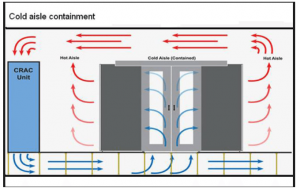With the rising popularity of hot/cold aisle containment, data center managers are often faced with the question, which is better – hot aisle or cold aisle containment?
It’s a hotly debated topic (pun intended). As I scoured the Internet for answers, the same observation kept popping up – “It depends”. While I was focused on the most efficient solution, the choice for hot aisle containment was less about being as efficient as possible, and more about what worked best for our particular situation.

Looking at the Big Picture
When trying to decide between hot vs. cold aisle containment, consider the cooling needs of other equipment. While I focused on hot vs. cold aisle efficiency, a colleague showed me a couple of different room layouts that included all of the equipment. It was clear that we would have to go with hot aisle containment, due to the fact that there would be namely UPS’s that would need cooling inside the same room. Cold aisle containment would make the rest of the room unbearably hot, suffocating our UPS’s. In fact, in one of our current data centers, our UPS’s have their own dedicated cooling units! The need to cool critical equipment outside of a server cold aisle made it clear we would be going with hot aisle containment.

A second fact that came to light changed a perceived inefficiency into a possible asset. While I thought with cold aisles it would be more efficient to cool a smaller, virtually airtight aisle than a large room with multiple entryways, I read a blog that shifted my perspective. In the case of a cooling system outage, having cooled the larger room creates a much larger volume of cool air, which acts as a kind of surplus for the servers in the event of a catastrophic cooling system failure. Having a larger volume of air to draw from would certainly extend the amount of time servers can run before having to draw in warm air. With cold aisle containment, you can imagine that once the CRAC units go down, the cool air would be depleted within minutes. We have various levels of redundancy, backup, and failover built into other systems, one more wouldn’t hurt.
The last point I want to make is that once we are set up with hot aisle containment, as our server racks become more densly packed, we can adopt powered chimneys. These work to actively remove the heat from the servers and balance the pressure so that bypass does not happen. I personally feel that this will be important as servers become more and more powerful.
Overall, I agree with and support the idea that the answer is “it depends”. After looking at our project particulars and reading lots of articles on the web (as well as the comments on those articles), we all agreed that hot aisle containment was the best option for our newest data center.

About Us
For more than 20 years, Prominic.NET has been operating data centers in Central Illinois that serve local and global clients. This year, Prominic.NET will expand into a third data center (with hot aisle containment) to accommodate high density servers with stringent uptime requirements.

